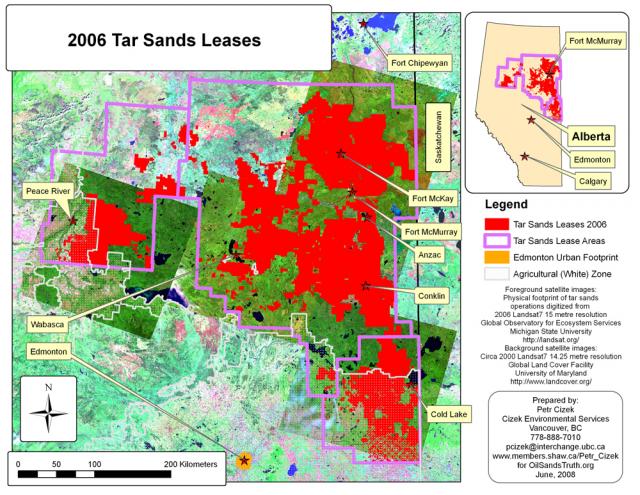F o r I n f o r m a t i v e D i a l o g u e o n W o r l d E v e n t s
About ·
Submissions ·
Archived Issues ·
Home
Volume 5
July 2009
Number 2
|
A Fading Forest:
Continual Oil Sands Expansion and the Gateway Pipeline Imagine
driving through miles and miles of unspoiled forest. Trees packed
together like a big family squeezing in for a portrait and animals migrating
here to the north where they still remain relatively safe. Now
imagine as you continue to drive the view suddenly shifts drastically
to massive open pits, smoking stacks, and black manmade pools of what
may have once been water. Thousands of people and machines scurrying
around like ants in an upside down anthill. Now imagine this tear
in the earth spreading to the size of the state of Florida. This
is the reality facing northern Albertans and many native communities
in the area. From Fort McMurray to Wabasca and across to Peace
River, the oil sands ventures show no sign of slowing down, despite pleas from
all forms of media and scientists around the world. One
of the biggest culprits in the continued expansion of oil sands is the
proposed gateway pipeline, slated to go into construction within the
next few years. These twin pipelines cover 1,170 kilometres from
Alberta's tar sands to the coast of BC. The pipeline is being
built by Enbridge Inc. who reported 67 spills in 2006 and 65 in 2007.
That's actually a reduction of 2 spills in a year! I wonder
if, at that rate of improvement, Alberta and BC communities will be
willing to roll the dice on having this project running through their
backyards. When the Enbridge people present their package to alleviate
concerns on reserves they seem very excited about having the opportunity
to cross 870 waterways and a little obstacle called the Rocky Mountains.
The waterways would not be altered in any way, they promised: besides
drilling test holes to check depths and having huge machines and the
camps of men it takes to drill under rivers and put in pipelines.
The mountains are another story. When asked how they would get
around the mountains they very plainly stated, "No need to go around,
our engineers think it would be a lot easier to just drill through them."
Obviously the pipeline guys hadn't had too much contact with the BC
First Nations who have counted on the protection of the mountains from elements
and enemies for generations, and consider them as much a part of their
tribes as their own families. "A
measure of our success will be our ability to provide meaningful economic
opportunities to First Nations and Métis communities, including an
option to invest in the project." This is from the Gateway website
and is one of the most stressed points in their aboriginal community
consultations. We can buy into this project. For many of
the elders this is the equivalent of paying to watch our way of life
burnt to ashes, then sell the ashes, then smile and count the money.
10% of the project is being set aside for native communities to buy
in and this is a great way for them to demonstrate to native organizations
and others that they indeed have the support of native communities.
But there are other partners involved in this project and Gateway employees,
in information sessions, were very pleased to mention this as well.
This will be the first time that oil companies will be directly financially
involved to this degree in a project like this. This is just another
illustration that this project will not only increase oil sands development
through the increase of oil flow from the area, it will also directly
increase big oil companies profits and growth. Let's help the
big oil companies to grow so that they can increase their development
and exert more influence on government policy and action towards the
oil sands projects. The fact is this:
"The Tar Sands "Gigaproject" is the largest industrial
project in human history and likely also the most destructive. The
tar sands mining procedure releases at least three times the CO2 emissions
as regular oil production and is slated to become the single largest
industrial contributor in North America to Climate Change. The tar sands are
already the cause of the second fastest rate of deforestation
on the planet behind the Amazon Rainforest Basin. Currently approved
projects will see 3 million barrels of tar sands mock crude produced
daily by 2018; for each barrel of oil, up to as high as five barrels
of water are used." Now
imagine driving through that forest again in a few years. You
are coming to that place again where the scenery suddenly turned black
and you are preparing yourself to see what has become of it. But
now things have changed, replanting has begun, reclamation is underway,
structures are being dismantled and equipment is being hauled away.
The water is clearing and the plants are growing once again. If
this future seems unlikely, and it probably does to many directly affected
by the oil sands, then it speaks to the amount of work to be done by
those who would like to one day see these monumental mistakes of mankind
undone. Until then, keep fighting. For
more information on the social justice movement opposing oil sand development
please visit www.oilsandstruth.org Dustin Twin Jr. is a Cree native from
Swan River, Alberta. He works in environmental studies and has always
been a traditional thinker when it comes to the environment. In addition
to work related studies Dustin writes comics, poetry and news articles.
He has had poems published in The Yellow Medicine Review, Autumn Leaves
journal, and the Angelic Dynamo poetry journal. |
